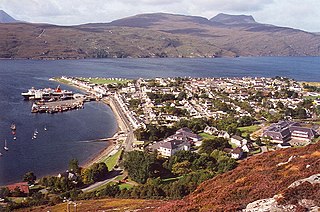Nestled on the northwest coast of Scotland, Ullapool is a captivating port town surrounded by dramatic landscapes and rich history. Known for its traditional music scene, picturesque harbour, and as a gateway to the Scottish Highlands, Ullapool attracts visitors seeking a blend of cultural heritage and natural beauty. The town is also a starting point for exploring the wilderness of the North West Highlands Geopark and the enchanting Isle of Lewis.
Be sure to visit the Ullapool Museum to delve into the town’s history, providing insight into its fishing heritage and clan culture.
For outdoor enthusiasts, a climb up Ullapool Hill offers breathtaking views of Loch Broom and beyond, ideal for a day hike.
Top things to do & see in Ullapool
Select the following sights and activities to discover best tickets and tours available in Ullapool.
Ullapool: A haven of Scottish highland beauty
| Country | Scotland |
| Time in Ullapool | GMT+0 |
| Language spoken | English |
| Population | 1,541 (source: 2021 Census) |
| Currency | Pound Sterling (£, GBP) |
| Airports |
|
Ullapool, nestled on the shores of Loch Broom in Northern Scotland, is a picturesque fishing village and an essential gateway to the Northern Highlands and the Hebrides. Known for its rugged natural beauty and cultural richness, Ullapool offers visitors a unique glimpse into Highlands life. Its origins date back to the 18th century when it was founded by the British Fisheries Society, and it has since developed an intriguing history intertwined with maritime and fishing heritage.
The village’s charm lies in its blend of natural landscapes and cultural festivities. Visitors can explore the nearby mountains, pristine lakes, and lush terrain that offer excellent opportunities for outdoor activities such as hiking, cycling, and boating. Ullapool is also renowned for its vibrant arts scene, hosting numerous events that celebrate local music, art, and literature, including the well-known Ullapool Book Festival.
The community’s spirit is palpable in its warm hospitality and the traditional Scottish music that fills the pubs on most evenings. Every year, tourists and music enthusiasts flock to Ullapool for the Loopallu Festival, turning the quiet town into a bustling hub of activity. There’s also an assortment of local crafts, jewelry, and galleries that showcase the work of regional artists, adding to the town’s creative landscape.
A visit to Ullapool wouldn’t be complete without sampling the local seafood, caught daily and served fresh in local restaurants. As a historical port town, it maintains a strong connection to its fishing roots, emphasized by the boats that still populate the harbor and the fish market buzzing with activity from early morning.
For those looking to delve deeper into Scotland’s natural and cultural heritage, Ullapool is a captivating destination that promises adventure, artistry, and awe-inspiring views. It is not just a stopover but a profound experience of tranquil beauty and enduring Scottish tradition.
Where is Ullapool?
Located in the northwest region of Scotland’s Highlands, Ullapool sits on the picturesque shores of Loch Broom.
Distances:
| Route | Distance by car | Time by car |
|---|---|---|
| Glasgow to Ullapool | 211 miles | Approx. 4 hours 5 mins |
| Edinburgh to Ullapool | 194 miles | Approx. 4 hours 15 mins |
| Inverness to Ullapool | 57 miles | Approx. 1 hour 15 mins |
What is Ullapool famous for?
Ullapool is celebrated for its stunning scenery, traditional Scottish culture, and as a hub for outdoor activities in the Scottish Highlands. It serves as a primary port for the Hebridean ferries, making it an integral part of Scotland’s transportation network.
History
Pre-18th Century
The area now known as Ullapool has a rich history, with evidence of early Mesolithic hunter-gatherers from around 4300 to 4500 BC. The region was later inhabited by Pictish tribes, known for their mysterious symbol stones, many of which can still be found in Scotland today.
1788 – 19th Century
Ullapool itself was founded in 1788 by the British Fisheries Society. Designed by Thomas Telford, the town was established to exploit the herring boom, which saw its harbor bustling with activity. Over the centuries, Ullapool became an important fishing port in the northwest Highlands.
20th Century – Present
Throughout the 20th century and into the 21st, Ullapool has transitioned from a fishing hub to a vital center for tourism, attracting visitors with its stunning landscapes and cultural heritage. Today, it serves as an important gateway to the Scottish Highlands, offering a combination of historical intrigue and natural beauty.
Visit Ullapool
What to see and do in Ullapool
Ullapool, nestled on the shores of Loch Broom, is a captivating destination for those who appreciate the great outdoors and cultural history. Visitors should not miss the Ullapool Museum housed in a charming church, offering insights into the local history. The surrounding landscapes are perfect for hiking, especially in the nearby Beinn Ghobhlach. For marine enthusiasts, sea tours are available to view dolphins and whales. Additionally, the village is known for its vibrant arts scene, with numerous galleries showcasing local art.
Festive Splendor in Ullapool
Ullapool hosts a variety of events throughout the year, including the celebrated Ullapool Book Festival in May and the lively Ullapool Guitar Festival in October. These events provide a great opportunity to experience the rich cultural fabric of the region.
Best time to visit Ullapool
The best time to visit Ullapool is during the late spring and summer months, from May to August, when the weather is most favorable and the days are long, allowing ample time for exploring and enjoying local events.
Is Ullapool worth visiting?
Ullapool is unquestionably worth visiting for those who cherish natural beauty, cultural history, and a peaceful yet vibrant atmosphere. It offers a unique blend of scenic attractions, outdoor activities, and cultural events that cater to a wide range of interests, making it a must-visit destination in the Scottish Highlands.









